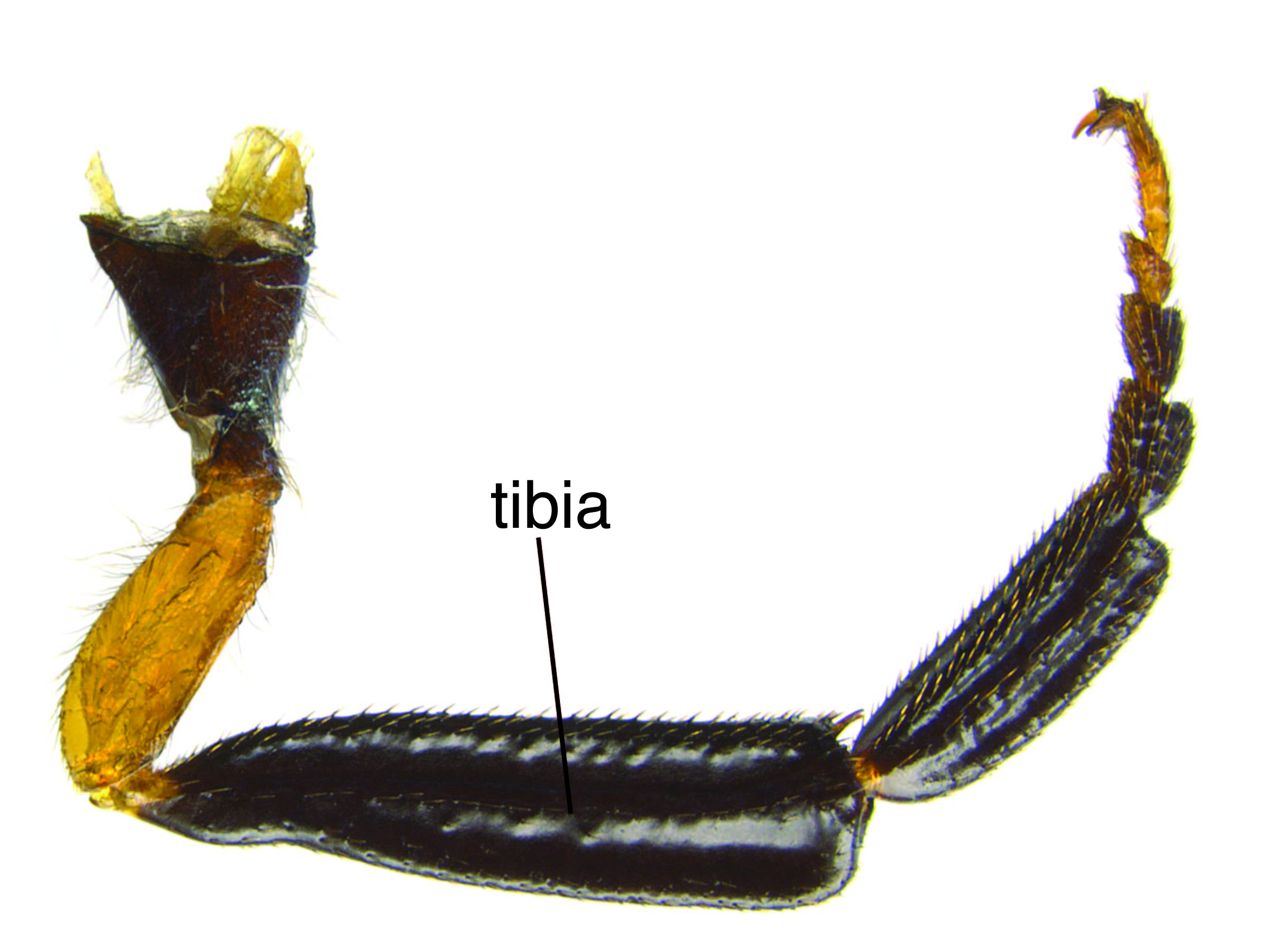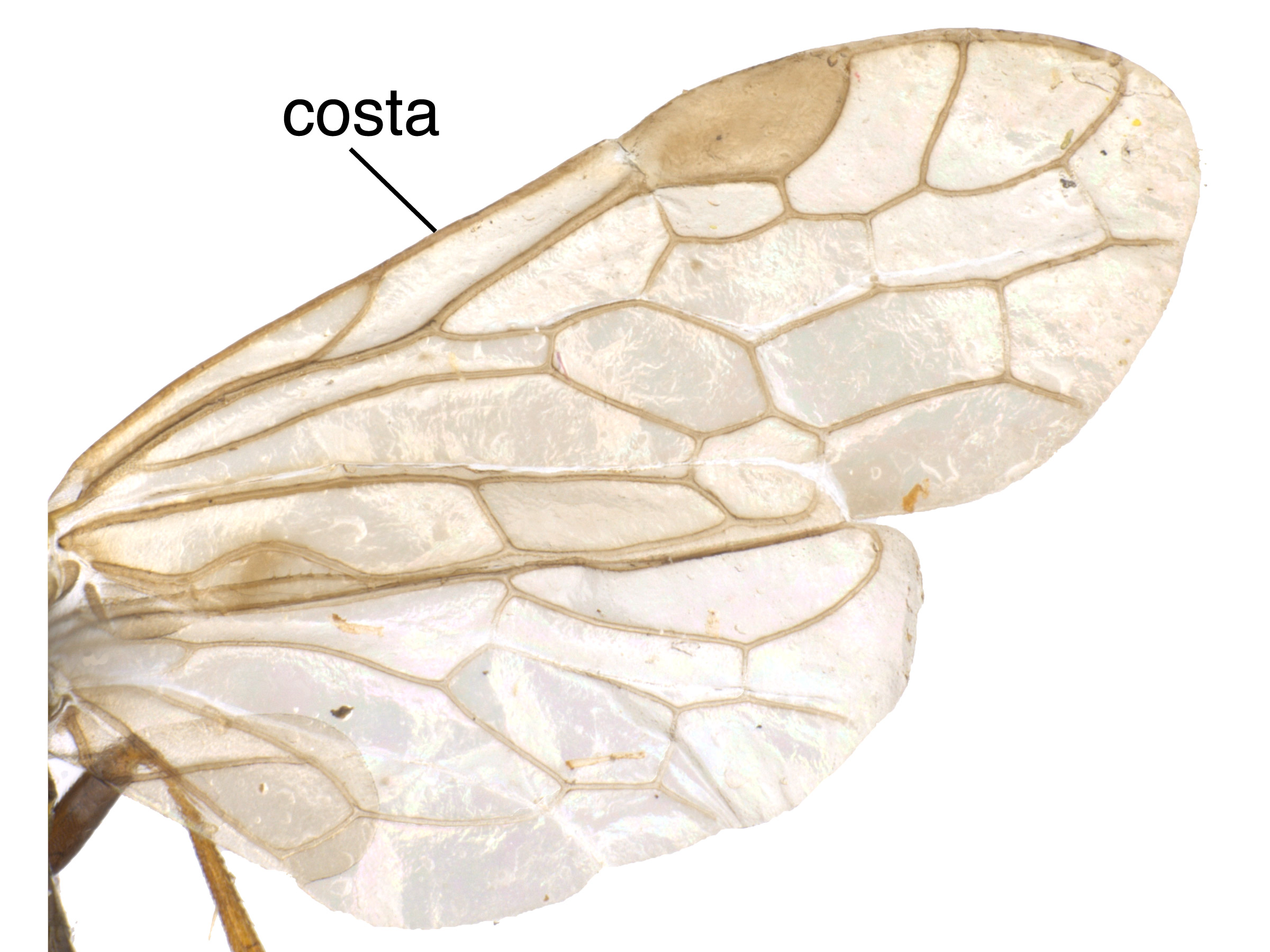Family: Siricidae
Subfamily: Siricinae
Genus: Sirex Linnaeus, 1760
Species: Sirex vates Mocsáry, 1881
Common names: none
Sirex vates is a rare black and yellowish-brown species from China (Smith 1978Smith 1978:
Smith DR. 1978. Suborder Symphyta (Xyelidae, Parachexyelidae, Parapamphiliidae, Xyelydidae, Karatavitidae, Gigasiricidae, Sepulcidae, Pseudosiricidae, Anaxyelidae, Siricidae, Xiphydriidae, Paroryssidae, Xyelotomidae, Blasticotomidae, Pergidae). Hymenopterorum Catalogus 14: 1-193.).
See Sirex for genus-level diagnostic characteristics.
The following characters are taken from the short, original description written in Latin (Mocsáry 1881). It was difficult to translate, and the translating authors and subsequent researchers have been unable to confirm their accuracy.
Females:
 1 blue, 2–7 dull yellowish-brown, and 8–9 shining and black (Mocsáry 1881)
1 blue, 2–7 dull yellowish-brown, and 8–9 shining and black (Mocsáry 1881) and tarsustarsus:
and tarsustarsus: reddish-brown; remaining tibiaetibia:
reddish-brown; remaining tibiaetibia: and tarsitarsus:
and tarsitarsus: black (Moscáry 1881)
black (Moscáry 1881) hyaline and/or dark bands near the center and at apexapex:
hyaline and/or dark bands near the center and at apexapex: brown (Mocsáry 1881)
brown (Mocsáry 1881) with 21 segments (Mocsáry 1881)
with 21 segments (Mocsáry 1881)Male S. vates is not known.
Female S. vates can be distinguished from similar species S. piceus by the clear fore wingfore wing:
the anterior wing of each pair of wings; usually the largest wing of the pair
 (Xiao and Wu 1983Xiao and Wu 1983:
(Xiao and Wu 1983Xiao and Wu 1983:
Xiao G and Jian W. 1983. The siricid wood wasps of China (Hymenoptera, Symphyta). Scientia Silvae Sinicae Memoirs of Forest Entomology 8: 1-29.), and from S. imperialis by the dull, non-metallic abdomenabdomen:
the third and last segment of an insect's body; in sawflies this is usually made up of 11 segments (segments 9 and 10 often fused) (Benson 1943Benson 1943:
(Benson 1943Benson 1943:
Benson RB. 1943. Studies in Siricidae, especially of Europe and southern Asia (Hymenoptera, Smphyta). Bulletin of Entomological Research 34 (1): 27-51. https://doi.org/10.1017/S0007485300023464).
none recorded
unknown
Female Sirex harbor symbiotic basidiomycete fungus in abdominal glands called mycangia. During oviposition, the site is inoculated with the fungus (Amylostereum spp.), which begins to decompose the surrounding wood. LarvaeLarva:
the immature stage of holometabolous insects
 feed on the fungus, and in the process bore galleries through the wood (Schiff et al. 2012Schiff et al. 2012:
feed on the fungus, and in the process bore galleries through the wood (Schiff et al. 2012Schiff et al. 2012:
Schiff NM, Goulet H, Smith DR, Boudreault C, Wilson AD, and Scheffler BE. 2012. Siricidae (Hymenoptera: Symphyta: Siricoidea) of the Western Hemisphere. Canadian Journal of Arthropod Identification 21: 1-305.).
Larvae are creamy white and grub-like in appearance with a dark head capsule. As with adults, larvaelarva:
the immature stage of holometabolous insects
 possess a short dorsaldorsal:
possess a short dorsaldorsal:
of or on the top surface of the body or structure
horn on the posterior end of the body. The larvaelarva:
the immature stage of holometabolous insects
 bore galleries into wood, feeding until pupation and subsequent emergence. Throughout this process, the larvaelarva:
bore galleries into wood, feeding until pupation and subsequent emergence. Throughout this process, the larvaelarva:
the immature stage of holometabolous insects
 use their horn to pack the tunnel behind them with sawdust. Emergence holes are perfectly circular. The fungal symbiont is carried in specialized organs in female larvaelarva:
use their horn to pack the tunnel behind them with sawdust. Emergence holes are perfectly circular. The fungal symbiont is carried in specialized organs in female larvaelarva:
the immature stage of holometabolous insects
 that develop into the mycangia after metamorphosis (Schiff et al. 2012Schiff et al. 2012:
that develop into the mycangia after metamorphosis (Schiff et al. 2012Schiff et al. 2012:
Schiff NM, Goulet H, Smith DR, Boudreault C, Wilson AD, and Scheffler BE. 2012. Siricidae (Hymenoptera: Symphyta: Siricoidea) of the Western Hemisphere. Canadian Journal of Arthropod Identification 21: 1-305.).
The specific biology of S. vates is unknown.
World: Sirex vates is found in northern China and in the province Sichuan (Mocsáry 1881, Smith 1978Smith 1978:
Smith DR. 1978. Suborder Symphyta (Xyelidae, Parachexyelidae, Parapamphiliidae, Xyelydidae, Karatavitidae, Gigasiricidae, Sepulcidae, Pseudosiricidae, Anaxyelidae, Siricidae, Xiphydriidae, Paroryssidae, Xyelotomidae, Blasticotomidae, Pergidae). Hymenopterorum Catalogus 14: 1-193.).
North America: not recorded
No specific locality data was available for mapping the range of this species at the time of publication.